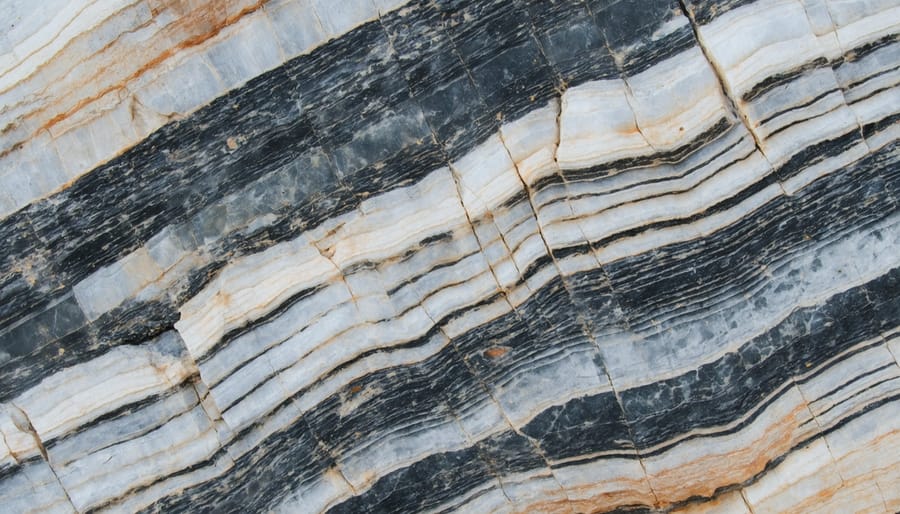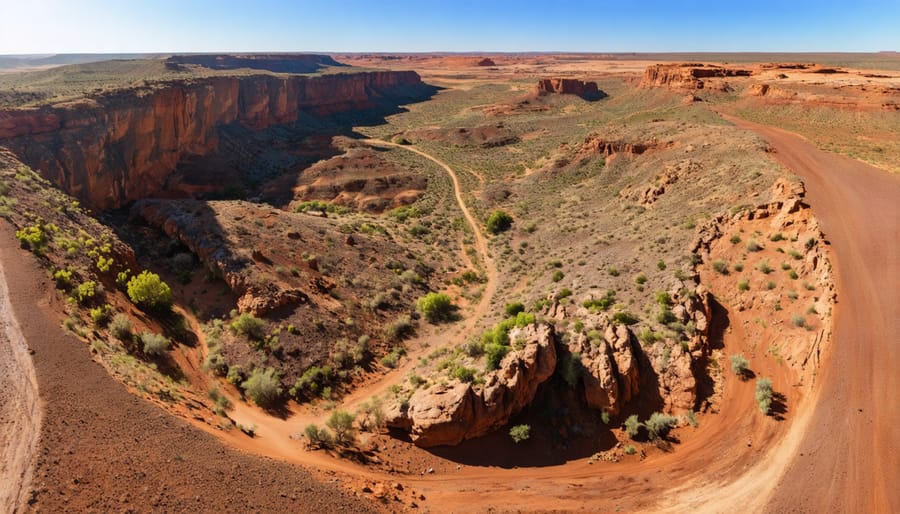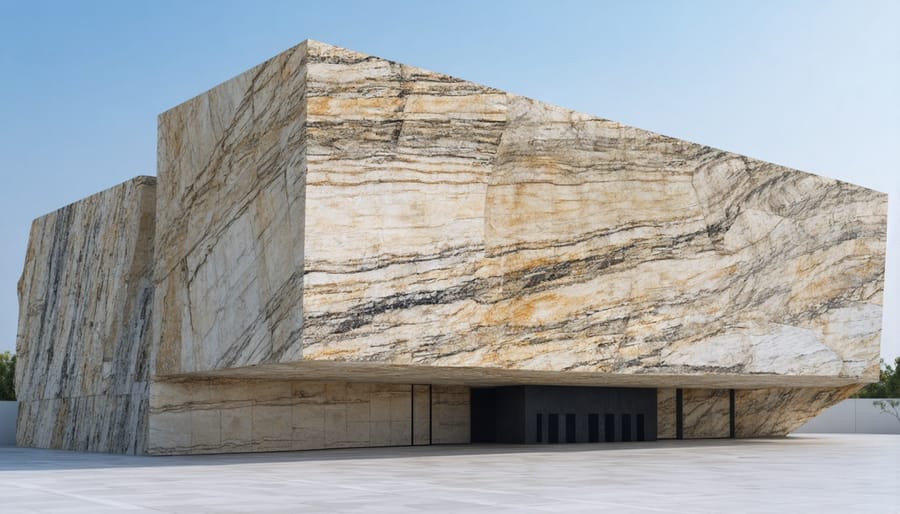Beneath our feet lies an ancient chronicle written in stone, stretching back an astounding 4 billion years. Earth’s oldest geological formations in nature stand as testament to our planet’s tumultuous birth, preserving secrets from when continents first emerged from primordial seas.
The Acasta Gneiss of Northwest Canada, dating back 4.03 billion years, holds the title of Earth’s oldest exposed rock formation. These metamorphic rocks, transformed under intense pressure and heat, offer invaluable insights into our planet’s earliest days. Not far behind in age, the Nuvvuagittuq Greenstone Belt in Quebec harbors rocks potentially as old as 4.28 billion years, though their exact age remains debated among geologists.
These ancient formations do more than mark time—they reveal the conditions present during Earth’s infancy, from the composition of early atmospheres to the emergence of the first continents. Today, these prehistoric stones continue to influence modern architecture and design, inspiring the use of natural stone in contemporary buildings while reminding us of our planet’s remarkable journey through time.
The Acasta Gneiss: Earth’s Oldest Known Rock Formation
Formation and Age
The Acasta Gneiss, located in Canada’s Northwest Territories, formed during Earth’s earliest geological period, the Hadean eon. These ancient rocks originated as igneous formations that underwent intense metamorphic processes, transforming them into the banded gneiss we see today. Scientists have dated these rocks using uranium-lead radiometric dating of zircon crystals found within the formation.
Through this precise dating method, researchers determined that the Acasta Gneiss is approximately 4.03 billion years old, making it the oldest known exposed rock formation on Earth. The zircon crystals within these rocks have remained remarkably stable over billions of years, preserving crucial information about Earth’s early history.
The formation’s composition suggests it originally formed as tonalite, a granite-like igneous rock, before being metamorphosed under extreme pressure and temperature conditions. This transformation occurred during the early stages of Earth’s crustal development when the planet was still experiencing frequent meteorite impacts and intense volcanic activity. The survival of these ancient rocks provides invaluable insights into Earth’s earliest geological processes and the formation of our planet’s first continental crust.

Composition and Characteristics
Earth’s oldest geological formations exhibit a complex mineral composition dominated by metamorphic and igneous rocks. These ancient formations primarily consist of gneiss, granite, and greenstone, which have undergone multiple cycles of transformation over billions of years. The Acasta Gneiss in Canada’s Northwest Territories features distinctive banding patterns of light and dark minerals, including quartz, feldspar, and various mafic minerals.
What makes these formations particularly remarkable is their preservation through intense geological processes. Despite extreme pressures, temperatures, and tectonic activities, they maintain recognizable structures and compositions that provide crucial insights into Earth’s early history. Many of these formations display unique characteristics such as pillow lavas, which indicate ancient underwater volcanic activity, and banded iron formations that reflect the evolution of Earth’s atmosphere.
The durability and resilience of these ancient stones make them valuable reference points for understanding modern natural stone formation and weathering processes, particularly relevant for construction and architectural applications.
Ancient Stone Formations Around the World
Australian Cratons
Western Australia holds some of Earth’s most ancient geological treasures, with the Pilbara Craton standing as one of the oldest and best-preserved crustal fragments on the planet. Dating back approximately 3.6 billion years, this remarkable formation provides an unprecedented window into Earth’s early history and the development of our planet’s crust.
The Pilbara region is particularly notable for its distinctive greenstone belts, which contain some of the earliest evidence of life on Earth. These ancient rock formations showcase beautifully preserved stromatolites – layered structures created by ancient microbial communities that once thrived in shallow seas.
The Yilgarn Craton, another significant Australian formation, spans most of Western Australia’s southern region and dates back to around 2.7 billion years. This vast expanse of ancient rock has become economically vital, hosting rich deposits of gold, nickel, and iron ore that are prized in modern construction and manufacturing.
What makes these Australian cratons particularly valuable to geologists and the construction industry is their exceptional preservation. Unlike many ancient formations worldwide that have been heavily altered by tectonic activity, these cratons retain much of their original characteristics. The distinct banding patterns, mineral compositions, and structural integrity of these formations continue to influence modern understanding of stone formation and durability in building applications.
The unique coloration and patterns found in these ancient rocks have also inspired numerous architectural designs, particularly in contemporary Australian buildings where locally sourced stone creates striking visual connections to the continent’s geological heritage.

Greenland’s Isua Supracrustal Belt
Located in southwestern Greenland, the Isua Supracrustal Belt stands as one of Earth’s most ancient and scientifically significant geological formations, dating back approximately 3.8 billion years. This remarkable belt consists of metamorphic rocks that have preserved crucial information about Earth’s early history, despite undergoing intense pressure and temperature changes over billions of years.
The formation spans roughly 35 kilometers in length and contains some of the oldest known sedimentary and volcanic rocks on Earth. What makes the Isua Belt particularly fascinating is its composition of banded iron formations, pillow lavas, and metasedimentary rocks, which provide invaluable insights into Earth’s primitive atmosphere and ocean chemistry.
Scientists have discovered evidence of early microbial life within these ancient rocks, making them crucial for understanding the origins of life on our planet. The presence of specific mineral compositions suggests that basic biological processes were already occurring when these rocks formed, during a time when Earth’s surface was vastly different from today.
The Isua Supracrustal Belt’s preservation is remarkable considering its age and the numerous geological processes it has endured. Its study continues to reveal new information about Earth’s earliest chapters, including details about primitive tectonic activity and the evolution of our planet’s crust. This formation serves as a geological time capsule, offering glimpses into conditions that existed on Earth nearly 4 billion years ago.
From Ancient Formation to Modern Building Material
Metamorphic Processes
Over billions of years, Earth’s oldest rocks have undergone remarkable transformations through metamorphic processes, creating the stunning building materials we use today. These transformations occur deep within the Earth’s crust, where intense heat and pressure alter the original rock’s mineral composition and structure. This natural process enhances the stone’s durability and creates distinctive patterns that make each piece unique.
Ancient formations, such as the Acasta Gneiss in Canada, demonstrate how metamorphism can transform ordinary rock into highly sought-after construction materials. The process realigns minerals, creating stronger bonds and often introducing beautiful banding patterns characteristic of gneiss and marble. These transformed rocks typically exhibit superior strength, resistance to weathering, and enhanced aesthetic appeal compared to their parent rocks.
The resulting materials serve various architectural applications, from decorative facades to sturdy foundation stones. For instance, metamorphosed limestone becomes marble, widely used in prestigious buildings worldwide. Similarly, ancient slate, formed from metamorphosed clay sediments, provides excellent roofing material due to its natural ability to split into thin, durable sheets.
Understanding these ancient transformations helps architects and designers select the most appropriate materials for their projects, ensuring both beauty and longevity in modern construction.
Modern Applications
Ancient geological formations continue to inspire modern architectural marvels, bridging millions of years of Earth’s history with contemporary design. Architects and designers frequently draw inspiration from these primordial structures, incorporating their distinctive patterns and textures into innovative building projects. The use of natural stone building materials allows creators to capture the essence of these ancient formations while delivering sustainable, durable solutions.
Notable examples include the Guggenheim Museum in Bilbao, Spain, whose titanium curves echo the fluid forms of metamorphic rock formations, and the Getty Center in Los Angeles, which features travertine cladding that pays homage to ancient limestone deposits. The Oslo Opera House in Norway demonstrates how angular stone geometries can mirror the dramatic forms of prehistoric rock outcroppings.
Contemporary architects also incorporate these ancient influences in more subtle ways, such as through textured wall surfaces that replicate geological striations, or by using stone veneers that showcase the natural patterns found in Earth’s oldest rock formations. This connection between prehistoric geology and modern design not only creates visually striking structures but also maintains a tangible link to our planet’s earliest history, reminding us of the enduring nature of stone as a building material.

Understanding Earth’s oldest geological formations provides invaluable insights into both our planet’s history and the natural stone materials we use today. These ancient formations, some dating back over 3.5 billion years, represent the foundation of our modern stone industry and continue to influence architectural and design choices worldwide.
By studying these primordial formations, we gain a deeper appreciation for the durability and timeless beauty of natural stone. The same geological processes that created these ancient structures – metamorphism, sedimentation, and volcanic activity – are responsible for producing the granite, marble, and other stone materials that grace our buildings and monuments today.
These formations also serve as living laboratories, helping us understand how different stone types weather and endure over immense periods. This knowledge proves invaluable when selecting materials for modern construction projects, particularly those designed to stand the test of time.
For industry professionals and consumers alike, recognizing the connection between Earth’s oldest formations and contemporary stone applications enhances our ability to make informed decisions about material selection and use. It reminds us that when we choose natural stone, we’re not just selecting a building material – we’re incorporating a piece of Earth’s ancient history into our modern environments.
As we continue to advance in sustainable construction practices, these geological formations remain crucial references for understanding the long-term performance and environmental impact of natural stone materials.










